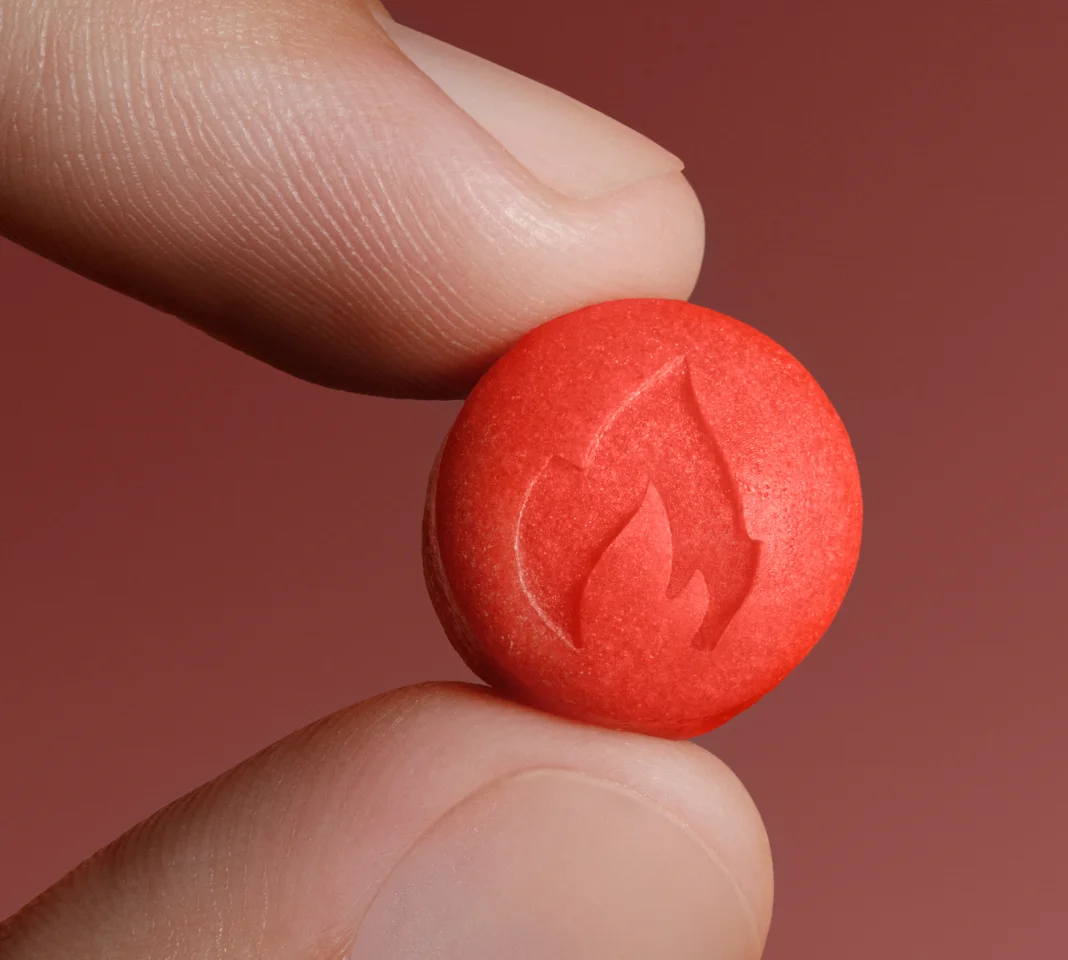Key takeaways
Vardenafil is a prescription medication FDA-approved to treat erectile dysfunction (ED).
The drug, which is the generic of Levitra and Staxyn (both of which have been discontinued), comes as oral tablets and orally disintegrating tablets in varying dosage strengths.
Common side effects of vardenafil include headache, flushing, runny nose, indigestion, dizziness, or back pain.
Here's what we'll cover
Here's what we'll cover
Here's what we'll cover
Key takeaways
Vardenafil is a prescription medication FDA-approved to treat erectile dysfunction (ED).
The drug, which is the generic of Levitra and Staxyn (both of which have been discontinued), comes as oral tablets and orally disintegrating tablets in varying dosage strengths.
Common side effects of vardenafil include headache, flushing, runny nose, indigestion, dizziness, or back pain.
Vardenafil is a prescription medication that treats erectile dysfunction (ED). It belongs to the same class of drugs as Viagra (sildenafil), Cialis (tadalafil), and Stendra (avanafil). So, what makes vardenafil different from other ED meds? Read on to find out and learn all about vardenafil side effects, drug interactions, and more.
What is vardenafil and how does it work?
Vardenafil is the active ingredient in and the generic name for the discontinued drugs, Levitra and Staxyn. It’s a medication approved by the US Food and Drug Administration to treat erectile dysfunction (ED). And while its brand-name versions are no longer on the market, vardenafil is still available today as oral tablets and orally disintegrating tablets (ODT) in varying strengths. (ODT sounds technical, but it’s just the pharmaceutical term for tablets you place on your tongue and wait to dissolve.)
Like Cialis and Viagra, vardenafil is a phosphodiesterase type 5 (PDE5) inhibitor. This type of prescription medication works by blocking the phosphodiesterase-5 (PDE5) enzyme, which breaks down cGMP, the chemical responsible for erections. By inhibiting PDE5, vardenafil allows cGMP to remain active longer, relaxing blood vessels and increasing blood flow to the penis. As a result, the drug can promote stronger, longer-lasting erections. But vardenafil is not a magic pill; it cannot give you an erection if you aren’t aroused. You need to be turned on for it to work effectively.
One reason vardenafil stands out among other ED medications is because of how quickly it starts working. While drug manufacturers recommend taking vardenafil around an hour before having sex, the medication can begin to have effects in as little as 10 minutes. For reference, Cialis typically kicks in about 30 minutes post-consumption while Viagra tends to take up to 60 minutes for most men.
Vardenafil uses
Vardenafil is approved by the US Food and Drug Administration (FDA) to treat ED, a common condition in which a person assigned male at birth (i.e. typically a man) has difficulty achieving or maintaining an erection strong enough for satisfactory sexual activity.
Vardenafil is also sometimes prescribed off-label to treat other medical conditions, including:
Raynaud's phenomenon, a disorder where your blood vessels tighten (constrict) primarily in the fingers and toes, decreasing blood flow
Pulmonary arterial hypertension, a condition where the blood flow in your lungs is at a higher pressure than normal, leading to the narrowing of blood vessels and increased pressure on your heart
Vardenafil dosages
Vardenafil dosage amounts vary depending on whether you are prescribed the oral tablet (the kind you swallow with water) or the dissolvable tablet (ODT). Vardenafil tablets come in four strengths—2.5 milligrams (mg), 5 mg, 10 mg, and 20 mg—while the dissolvable medication is only available in 10 mg.
Other factors that can influence the strength prescribed are age, underlying health conditions, and other medications being taken. For most people, the recommended starting dose of vardenafil is 10 mg. Your healthcare provider may adjust your dosage up to 20 mg or down to 5 mg depending on the drug’s effectiveness and your tolerance for side effects.
If you are 65 years of age or older, your healthcare provider may have you start with 5 mg dosage instead. The 5 mg dosage is also recommended for people taking alpha-blockers or those with chronic liver failure.
People taking certain medications, including CYP3A4 inhibitors like ritonavir or clarithromycin, may need to start with an even lower dosage of 2.5 mg. They may also need to take vardenafil less frequently. Your healthcare provider can give you specific dosage recommendations.
How to take vardenafil
You should take vardenafil around 1 hour before you plan on having sex. You can take vardenafil with or without food, but it may work faster if you take it on an empty stomach. Research has shown that taking vardenafil with food, especially high-fat meals, may delay the drug’s effects by up to 1 hour. Vardenafil tablets can be swallowed with water, while ODT vardenafil should be taken without liquid. Simply place it on your tongue, and let it dissolve.
Whatever dose you are prescribed, you should not take more than one dose of vardenafil per day. If you take certain medications, such as CYP3A4 inhibitors, or have liver problems, your healthcare provider may recommend taking vardenafil less frequently or starting it at a lower dose.
| Oral vardenafil tablet | Dissolvable vardenafil |
Dosage strengths | 2.5 mg, 5 mg, 10 mg, 20 mg | 10 mg |
Recommended time to take it for ED | Swallow 1 hour before sexual activity | Place on the tongue and let it dissolve 1 hour before sex |
Food and water | Can take it with or without food; high-fat meals may delay effects | Do not take with water; let dissolve fully on tongue before drinking or eating |
Vardenafil side effects
The most common side effects of vardenafil include:
Headache
Flushing
Runny nose or congestion
Indigestion
Dizziness
Back pain
Although rare, vardenafil can cause more serious side effects, including:
Priapism, a prolonged, sometimes painful, erection lasting 4 or more hours that requires emergency treatment
Sudden loss of vision in one or both eyes
Sudden decrease or loss of hearing
Drop in blood pressure (hypotension)
Seek medical attention immediately if you experience any of these concerning side effects. In many cases, they are treatable.
Vardenafil drug interactions
Vardenafil is known to interact with certain medications, including:
Nitrates: Nitrates includes both prescription medications like nitroglycerin, which is used to treat chest pain (angina), as well as recreational drugs like amyl nitrites (more popularly known as “poppers”). When taken with nitrates, vardenafil may cause a potentially fatal drop in blood pressure.
Guanylate cyclase (GC) stimulators: GC stimulators, such as riociguat (Adempas), also should not be taken with vardenafil. Because both drugs reduce blood pressure, taking them together can lead to a potentially dangerous drop in your body’s pressure levels.
CYP3A4 inhibitors: Because these medications interfere with the enzyme CYP3A4 (thus the name) in your liver, they may affect how your liver processes drugs and increase your risk of experiencing side effects on vardenafil. Grapefruit juice may also act on this enzyme and raise vardenafil drug levels. Examples of CYP3A4 inhibitors include ritonavir, cobicistat, indinavir, saquinavir, atazanavir, ketoconazole, itraconazole, clarithromycin, and erythromycin.
Alpha-blockers: Alpha-blockers, such as doxazosin, terazosin, alfuzosin, and tamsulosin, are used to help lower blood pressure and treat certain prostate conditions, such as benign prostatic hyperplasia (BPH). So, combining them with vardenafil could make your blood pressure too low.
Before starting vardenafil (or any prescription medication for that matter),talk to your healthcare provider. Share a complete list of any other medications you are taking, including over-the-counter supplements. This way, they can determine whether vardenafil may be safe for you and prescribe an appropriate dosage or recommend another ED treatment.
Vardenafil warnings
Vardenafil is approved for treating ED in adults (those 18 years old and older). Vardenafil is not safe for some people to take, including those who are not healthy enough for sexual activity. If you have any of the following health conditions, you should avoid taking vardenafil as it can increase your risk of experiencing serious side effects:
Heart problems, including a history of heart disease, heart failure, or a prolonged QT interval (a problem with your heart's electrical system)
Eye problems, including a history of non-arteritic ischemic optic neuropathy (NAION) or a crowded optic disc
Allergies to vardenafil or any of the inactive ingredients in the medication
Alternatives to vardenafil for erectile dysfunction
If you’re not sure vardenafil is for you, you’ve got options. For one thing, it’s not the only PDE5 inhibitor on the market. Other PDE5 inhibitors include sildenafil, tadalafil, and avanafil as well as their brand-name versions of Viagra, Cialis, and Stendra, respectively.
Here’s a look at how vardenafil compares to the other ED medications:
| Vardenafil | Sildenafil | Tadalafil | Avanafil |
Brand name | Formerly Levitra and Staxyn, both of which are discontinued | Viagra | Cialis | Stendra |
Dose | Oral tablet: 2.5 mg, 5 mg, 10 mg, 20 mg
Orally disintegrating tablet: 10 mg | Oral tablet: 25 mg, 50 mg, 100 mg | Oral tablet: 2.5 mg, 5 mg, 10 mg, 20 mg | Oral tablet: 50 mg, 100 mg, 200 mg |
How do you take it? | Oral or dissolvable tablet taken as-needed, 1 hour before sex | Oral tablet taken as-needed, 1 hour before sex | Oral tablet taken once daily or as-needed, 1 hour before sex | Oral tablet taken as-needed, 15 to 30 minutes before sex |
How long does it take to work? | 10–30 minutes | 30–60 minutes | 20–120 minutes | 15–45 minutes |
Food | Can take with or without food; high-fat meals may make it take longer to work | Can take with or without food; high-fat meals may make it take longer to work | Can take with or without food | Can take with or without food; high-fat meals may make it take longer to work |
How long does it last? | 5–7 hours | 4–6 hours | 24–36 hours | 5 hours |
Some PDE5 inhibitors are also available in alternative formulations. Ro’s Daily Rise Gummies, for example, are fruit-flavored, once-daily gummies that each contain 7 mg of tadalafil. Meanwhile, Ro Sparks is a sublingual ED treatment that combines tadalafil and sildenafil, the active ingredients in Cialis and Viagra, and dissolves under your tongue for fast-acting results.
Frequently asked questions
Below we answer some frequently asked questions about vardenafil.
Is vardenafil the same as Viagra?
Is vardenafil sold over the counter?
How long does vardenafil last?
DISCLAIMER
If you have any medical questions or concerns, please talk to your healthcare provider. The articles on Health Guide are underpinned by peer-reviewed research and information drawn from medical societies and governmental agencies. However, they are not a substitute for professional medical advice, diagnosis, or treatment.
Viagra Important Safety Information: Read more about serious warnings and safety info.
Cialis Important Safety Information: Read more about serious warnings and safety info.
References
Barnes, H., Brown, Z., Burns, A., & Williams, T. (2019). Phosphodiesterase 5 inhibitors for pulmonary hypertension. The Cochrane Database of Systematic Reviews, 1(1), CD012621. doi: 10.1002/14651858.CD012621.pub2. Retrieved from https://pubmed.ncbi.nlm.nih.gov/30701543/
Bourin, M. (2018). Clinical Pharmacology of Phosphodiesterase 5 Inhibitors in Erectile Dysfunction. SOA Archives of Pharmacy & Pharmacology, 1(1), 1–6. Retrieved from https://scientonline.org/open-access/clinical-pharmacology-of-phosphodiesterase-5-inhibitors-in-erectile-dysfunction.pdf
Caglayan, E., Axmann, S., Hellmich, M., et al. (2012). Vardenafil for the treatment of Raynaud phenomenon: a randomized, Double-blind, Placebo-Controlled Crossover study. Archives of Internal Medicine, 172(15). doi: 10.1001/archinternmed.2012.2271. Retrieved from https://jamanetwork.com/journals/jamainternalmedicine/fullarticle/1188038
DailyMed. (2024). Label: Vardenafil hydrochloride tablet. National Library of Medicine. Retrieved Aug. 28, 2024 from https://dailymed.nlm.nih.gov/dailymed/drugInfo.cfm?setid=2782efed-6198-47b9-81ac-3e255e2ab7f6
DailyMed. (2023). Label: Vardenafil tablet, orally disintegrating. National Library of Medicine. Retrieved Aug. 28, 2024 from https://dailymed.nlm.nih.gov/dailymed/drugInfo.cfm?setid=0ce4eb7b-fa50-441d-ae71-eb33dca27926
Dhaliwal, A. & Gupta, M. (2023). PDE5 Inhibitors. StatPearls. Retrieved Aug. 28, 2024 from https://www.ncbi.nlm.nih.gov/books/NBK549843/
Generali, J. A. & Cada, D. J. (2013). Vardenafil: raynaud phenomenon. Hospital Pharmacy, 48(1), 20–22. doi: 10.1310/hpj4801-20. Retrieved from https://www.ncbi.nlm.nih.gov/pmc/articles/PMC3839438/
Huang, S. A. & Lie, J. D. (2013). Phosphodiesterase-5 (PDE5) Inhibitors In the Management of Erectile Dysfunction. P & T: A Peer-Reviewed Journal for Formulary Management, 38(7), 407–419. Retrieved from https://www.ncbi.nlm.nih.gov/pmc/articles/PMC3776492/
Leslie, S. W. & Sooriyamoorthy, T. (2024). Erectile Dysfunction. StatPearls. Retrieved Aug. 28, 2024 from https://www.ncbi.nlm.nih.gov/books/NBK562253/
Shin, Y. E., Rojanasarot, S., Hincapie, A. L., et al. (2023). Safety profile and signal detection of phosphodiesterase type 5 inhibitors for erectile dysfunction: a Food and Drug Administration Adverse Event Reporting System analysis. Sexual Medicine, 11(5), qfad059. doi: 10.1093/sexmed/qfad059. Retrieved from https://www.ncbi.nlm.nih.gov/pmc/articles/PMC10687329/
U.S. Food and Drug Administration (FDA). (n.d.). Orange Book: Approved Drug Products with Therapeutic Equivalence Evaluations. Retrieved from https://www.accessdata.fda.gov/scripts/cder/ob/results_product.cfm?Appl_Type=A&Appl_No=208324#37112
Zucchi, A., Costantini, E., Scroppo, F. I., et al. (2019). The first-generation phosphodiesterase 5 inhibitors and their pharmacokinetic issue. Andrology, 7(6), 804–817. doi: 10.1111/andr.12683. Retrieved from https://www.ncbi.nlm.nih.gov/pmc/articles/PMC6790582/












